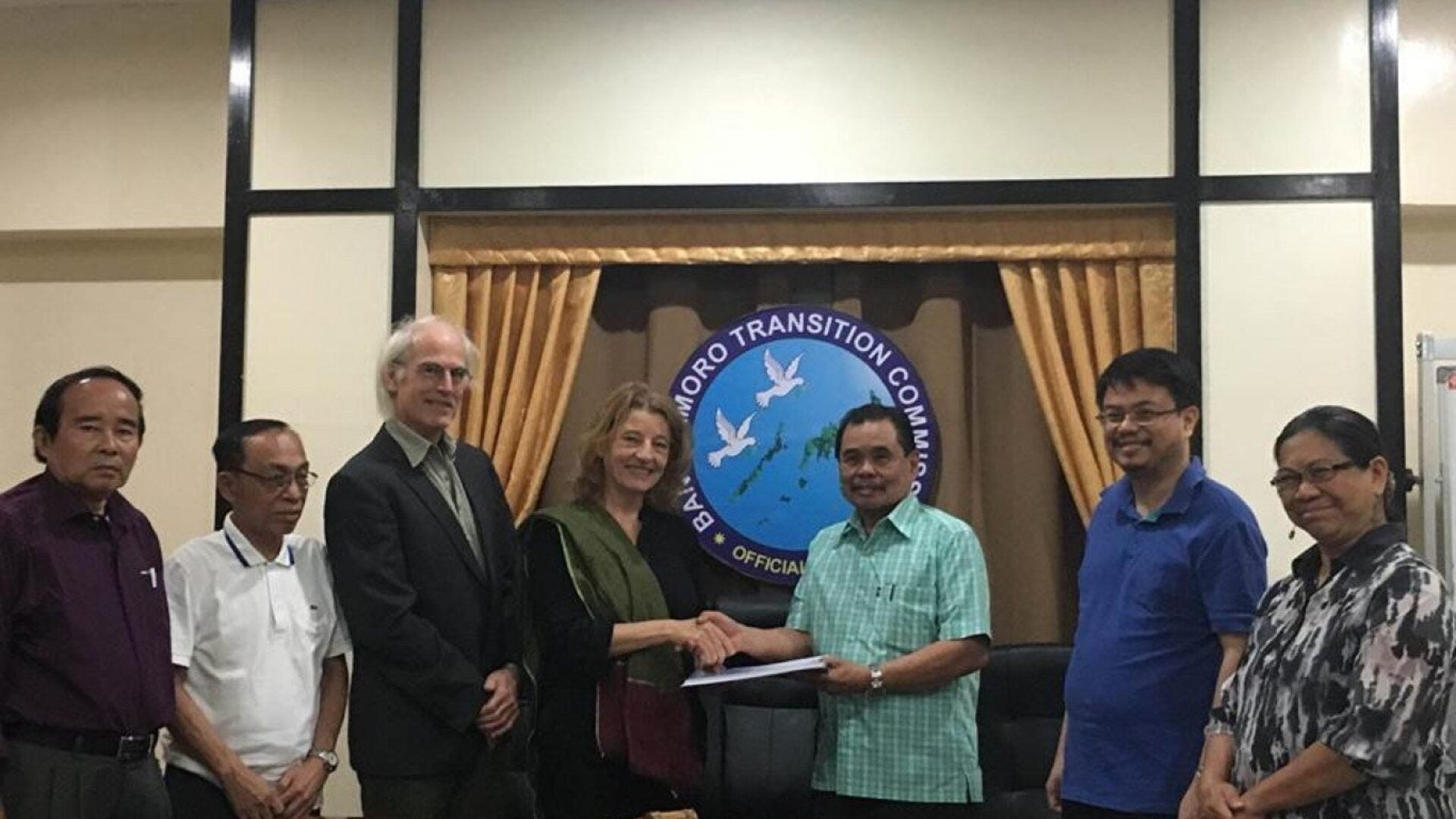The Report of the Philippine Transitional Justice & Reconciliation Commission: Amplifying the Voices of Women

An important milestone has been achieved in the peace process in the Philippines. The Transitional Justice and Reconciliation Commission (TJRC) issued its report, which is cause for reflection relating to its findings and for the next steps.
Background of the TJRC report
The foundation for the current peace process in the Philippines, the Comprehensive Agreement on the Bangsamoro of 2014, includes a Framework Agreement and annexes relating to transitional arrangements, wealth sharing, power-sharing and normalization. The annex on normalization contains the terms of reference of the TJRC. The role envisaged for the TJRC was to assess and provide recommendations and expert advice to the peace panels regarding “legitimate grievances,” “historical injustices,” “human rights violations and marginalization through land dispossession” of the Bangsamoro people, with the aim of “healing and reconciliation.” The TJRC was also at liberty to identify other aspects of transitional justice and reconciliation, as relevant to its work. The aim of the work of the TJRC was to address the root causes of conflict, with a view towards prevention and non-recurrence. Based on this mandate, the TJRC commenced work in late 2014.
The report of the TJRC was handed to the peace panels in December 2015, and released to the public on 15 and 16 March 2016, in Cotabato City and Manila respectively. The report is detailed and examines various issues related to the conflict, providing approximately 90 recommendations. The methodology adopted by the TJRC included a consultation process that consisted of listening sessions across various communities in Mindanao, reaching and canvassing more than 3,000 people. There have also been expert studies commissioned and analyses of the various issues by means of key policy interviews. The synthesis of these activities resulted in the current report.
Significant findings and recommendations of the TJRC Report
The TJRC found that there are indeed legitimate grievances, historical injustices, human rights violations and marginalization due to land dispossession. The report finds that these violations have arisen due to systematic violence by the state, a culture of impunity and state neglect. The root cause is linked to the imposition of a monolithic Filipino identity by the Philippine state.
Human rights violations, land dispossession and the status of women and indigenous people affected by decades of conflict are but some of the issues addressed. While the TJRC report delves into detail with regard to the consequences as well as causes of the enumerated violations, I will elaborate on three areas: violations of human rights and humanitarian law, land dispossession and the impact of both these concerns on women.
The first significant findings relate to violations of international humanitarian law and human rights in general. The TJRC examined different categories of crimes, such as sexual violence, internal displacement, recruitment of child soldiers, extrajudicial killings, torture and enforced disappearances, among others. The TJRC report canvassed existing and known incidents of mass atrocity crimes that occurred in the course of the conflict, and also highlighted lesser known incidents and violations requiring further investigation. While the TJRC found that the majority of the crimes were committed by state forces or those affiliated to the state, there were also violations by the non-state armed groups. The TJRC is adamant that there must be formal investigations and accountability for all parties that may have committed these violations. Linked to these findings, the report also raises the lack of official records or database related to violations of human rights and humanitarian law as an important gap.
Another integral concern related to the conflict is that of land dispossession. The adverse and continuing impact of land dispossession on the inhabitants and communities in Mindanao cannot be underestimated. The roots of such land dispossession emanated from Spanish, American and Japanese colonial rule, and their continued institutionalization in current laws and policies play a major role in the conflict. The inherent link and relationship to the land of the Moro and indigenous peoples as guardians or stewards of the land for the benefit of all is linked to questions of culture and identity, and is, therefore, all the more crucial to the resolution of the conflict. The programs of resettlement over the decades and corporate possession of lands have been singled out for particular scrutiny.
Cross-cutting both international human rights and international humanitarian law violations, and issues of land dispossession is the impact on women. The TJRC report highlights the systematic use of rape and sexual violence targeting women from the Moro and indigenous communities before and during the Martial law period, in particular, as a means of disrupting the very fabric of the community. This gendered and cultural component of the violence meted out to women is elaborated on, with examples of incidents that have received less attention, such as the ‘Malisbong Massacre,’ during which women were taken hostage on naval vessels, sexually assaulted and then killed. During the period of martial law, sexual slavery was another means of perpetuating violence against women. Subsequent to martial law, there have been other recorded violations, including, more commonly, trafficking in women. An important factor that the TJRC listening process highlights is the shame and stigma associated with these violations, on the part of the women and also the community at large, which has hindered discussion of these crimes.
In addition to the human rights and humanitarian law violations specifically affecting women, there is a detrimental and disproportionate impact of land dispossession and the conflict on women. In many cases, women often have no title to property and have tenuous legal rights. In armed conflict, the lack of access to resources by women is exacerbated, given their lack of legal standing and inability to access property. As a result, the impact of the conflict on the women of the Bangsamoro has been felt in multiple and devastating ways.
Based on these findings, among others, the TJRC recommends the establishment of a National Transitional Justice and Reconciliation Commission for the Bangsamoro (NTJRCB). The TJRC report provides detail with regard to the structure and functioning of the commission, as well as specifically how its work should be carried out. The NTJRCB would have extensive powers, including subpoena powers, for the appearance of persons and documentation, and the ability to keep testimony confidential. The NTJRCB would also have four sub-commissions pertaining to historical memory, impunity, land dispossession and healing and reconciliation. Per the enumerated mandate for the sub-commission on historical memory, this body would function partly as a fact-finding and truth seeking body. It would be responsible for listening to victims’ testimony, gathering evidence, investigating serious violations of international human rights and international humanitarian law, and assessing emblematic cases. It would also be tasked with the determination of whether these violations were part of a deliberate strategy, which is of particular relevance related to violations against women. The sub-commission on impunity would make recommendations regarding all policies and laws impacting impunity, and this would include disciplinary measures against public officials. The sub-commission on land dispossession would be tasked with setting up a dispute resolution mechanism for land disputes, as well as creating databases regarding land ownership for resolution of conflict and restitution. The sub-commission on healing and reconciliation would identify traditional reconciliation practices and promote national reconciliation.
Key lessons
There are a few important takeaways from the TJRC report. First, the TJRC report is the first official recording and acknowledgement of the structural issues and causes for the conflict, as well as an accounting of myriad violations, both at the institutional level and their impact on the ground. As stated by one of the individuals giving a testimonial at the launch of the TJRC report in Manila, the report would help in the trajectory towards “a more inclusive and truthful history.” Furthermore, the focus on the marginalized voices of women is a significant step.
Linked to this is the listening process undertaken by the TJRC. In and of itself, such a process is important for victims to be heard, as well as to establish a formal record and a basis for healing and reconciliation. While these may have been recorded by non-governmental organizations, this is an important step of officially placing these violations on record and acknowledging the occurrence of these events. Further, it helps bring to light lesser known instances or events that occurred, but did not receive due attention. This process enabled voices of women to be heard more clearly, with a recording of the multiple violations of human rights and humanitarian law, as well as the economic impact of the conflict. While the TJRC has been very clear in stating that it is not a fact-finding body or a truth commission, in effect the listening process as well as the collection of data and evidence has imbued it with some of the functions and results of a truth commission.
The recommendations issued by the TJRC are broad-based but also contain substantial detail as to their implementation. The recommendations address not only issues related to structural causes of the conflict, but also delve into the minutiae of what needs to be done, by whom and how. Strengths of the report’s recommendations are their future orientation and focus towards prevention and non-recurrence. The recommendations also include more holistic educational and memorialization initiatives, as well as initiatives such as vetting and removal of officials for corruption and a broader development agenda. Recommendations for capacity building for women regarding their rights including property rights, greater political participation, as well as the formulation of action plans for peace and security in accordance with U.N. Security Council Resolution 1325, all serve to place women on the agenda more emphatically.
The main challenge arising from the TJRC report relates to translating the recommendations into reality. While much depends on political will and the next administration, some of the ‘asks’ in the report can already be set in motion. These include commencing the creation of a database on all human rights and humanitarian law violations, revisiting aspects of the educational curricula, creation of spaces of further dialogue, consultative plans for memorialization and the issuing of apologies.
While this is a relatively unique instance where initiatives of dealing with the past are continuing apace with a peace agreement, setbacks in implementing the peace agreement, as well as in lack of follow-through on the recommendations of a body such as the TJRC, may impede the entire process.
In the ultimate analysis, the TJRC report recommendations may be viewed as the presentation of a roadmap, taking into account myriad factors that continue to impact the prospects for peace. While it is a significant step, following through on the recommendations will be a measure of its success.
Priya Pillai is a lawyer, with a Ph.D in international law and transitional justice from the Graduate Institute of International and Development Studies, Geneva. She has worked at the United Nations International Criminal Tribunal for the Former Yugoslavia, the International Federation of Red Cross and Red Crescent Societies and on various international law and human rights advocacy campaigns. Priya has an LL.M from New York University and a law degree from the National Law School of India University, Bangalore, India. She is currently based in Manila, and can be contacted at pillai_p@hotmail.com.
Explore More

End of Year Reflections
This year has been particularly challenging for peace around the world, with…

“No Amnesty, No Silence:” Ukrainian Women Urge Accountability for War-Time Sexual Violence
Last week, the Georgetown Institute for Women, Peace and Security (GIWPS) brought…
